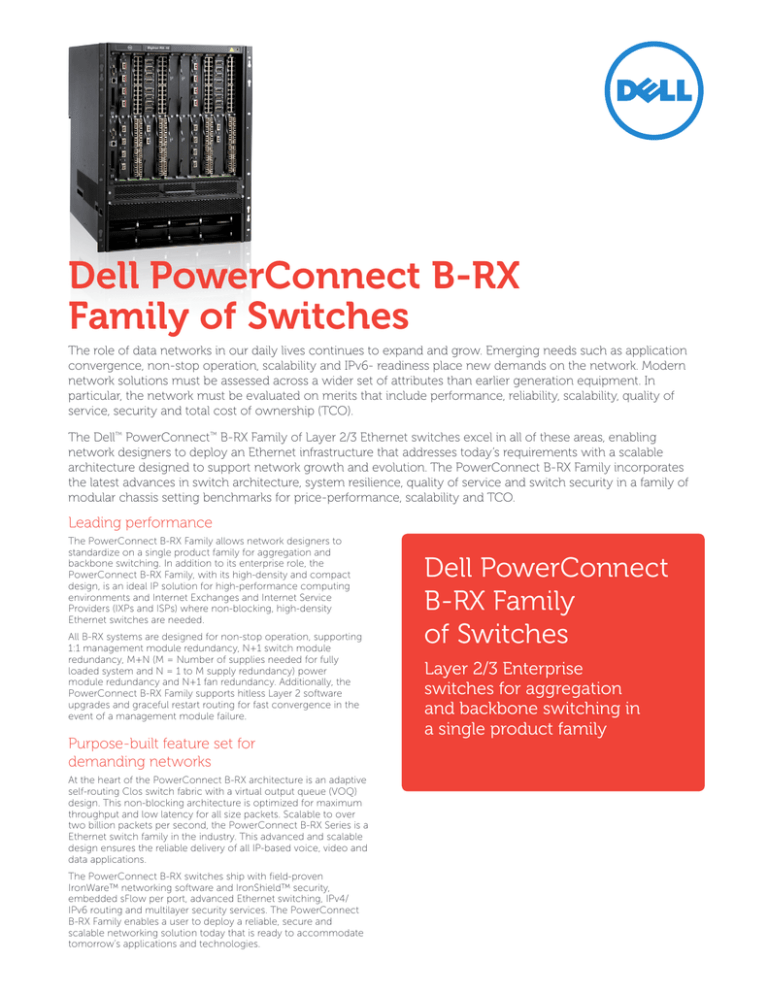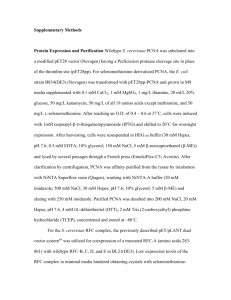
Dell PowerConnect B-RX
Family of Switches
The role of data networks in our daily lives continues to expand and grow. Emerging needs such as application
convergence, non-stop operation, scalability and IPv6- readiness place new demands on the network. Modern
network solutions must be assessed across a wider set of attributes than earlier generation equipment. In
particular, the network must be evaluated on merits that include performance, reliability, scalability, quality of
service, security and total cost of ownership (TCO).
The Dell™ PowerConnect™ B-RX Family of Layer 2/3 Ethernet switches excel in all of these areas, enabling
network designers to deploy an Ethernet infrastructure that addresses today’s requirements with a scalable
architecture designed to support network growth and evolution. The PowerConnect B-RX Family incorporates
the latest advances in switch architecture, system resilience, quality of service and switch security in a family of
modular chassis setting benchmarks for price-performance, scalability and TCO.
Leading performance
The PowerConnect B-RX Family allows network designers to
standardize on a single product family for aggregation and
backbone switching. In addition to its enterprise role, the
PowerConnect B-RX Family, with its high-density and compact
design, is an ideal IP solution for high-performance computing
environments and Internet Exchanges and Internet Service
Providers (IXPs and ISPs) where non-blocking, high-density
Ethernet switches are needed.
All B-RX systems are designed for non-stop operation, supporting
1:1 management module redundancy, N+1 switch module
redundancy, M+N (M = Number of supplies needed for fully
loaded system and N = 1 to M supply redundancy) power
module redundancy and N+1 fan redundancy. Additionally, the
PowerConnect B-RX Family supports hitless Layer 2 software
upgrades and graceful restart routing for fast convergence in the
event of a management module failure.
Purpose-built feature set for
demanding networks
At the heart of the PowerConnect B-RX architecture is an adaptive
self-routing Clos switch fabric with a virtual output queue (VOQ)
design. This non-blocking architecture is optimized for maximum
throughput and low latency for all size packets. Scalable to over
two billion packets per second, the PowerConnect B-RX Series is a
Ethernet switch family in the industry. This advanced and scalable
design ensures the reliable delivery of all IP-based voice, video and
data applications.
The PowerConnect B-RX switches ship with field-proven
IronWare™ networking software and IronShield™ security,
embedded sFlow per port, advanced Ethernet switching, IPv4/
IPv6 routing and multilayer security services. The PowerConnect
B-RX Family enables a user to deploy a reliable, secure and
scalable networking solution today that is ready to accommodate
tomorrow’s applications and technologies.
Dell PowerConnect
B-RX Family
of Switches
Layer 2/3 Enterprise
switches for aggregation
and backbone switching in
a single product family
Features
Dell™ PowerConnect™ B-RX Family of Switches
B-RX 4
I/O Module Slots
B-RX 8
B-RX 16
4
8
16
Available data capacity
400 Gbps
800 Gbps
1.60 Tbps
Total switch capacity
960 Gbps
1.92 Tbps
3.84 Tbps
Packet forwarding capacity
286 Mpps
571 Mbps
1,142 Mpps
Max 10-GbE ports per system1
64
128
256
Max 1-GbE ports per system
192
384
768
Height (inches/rack units)
Airflow
Power supply redundancy
Dimensions
Weight
RFC Compliance
7”/4RU
12.25”/7RU
24.5"/14RU
Side-to-Side
Side-to-Side
Front-to-Back
M+N
M+N
M+N
17.45w x 6.96h x 22.5d in
44.32w x 17.68h x 57.15d cm
17.45w x 12.21h x 22.5d in
44.32w x 31.01h x 57.15d cm
17.45w x 24.47h x 25.5d in
44.32w x 62.15h x 64.77d cm
78 Lbs
35 Kg
131 Lbs
60 Kg
236 lbs
107 kg
BGPv4: RFC 4271 BGPv4; RFC 1745 OSPF interactions; RFC 1997 Communities & Attributes; RFC 2439 route flap
dampening; RFC 2796 route reflection; RFC 3065 BGP4 confederations; RFC 3392 Capability Advertisement; RFC 2918 Route
Refresh Capability; RFC 1269 Managed Objects for BGP; RFC 1657 Managed Objects for BGP-4 using SMIv2; RFC 3682
Generalized TTL Security Mechanism for eBGP Session Protection; RFC 2385 BGP Session Protection via TCP MD5;
draft-ietf-idr-restart Graceful Restart for BGP; draft-ieft-idr-route-filter
OSPF: RFC 2178 OSPF; RFC 1583 OSPF v2; RFC 3101 OSPF NSSA; RFC 1745 OSPF Interactions; RFC 1765 OSPF Database
Overflow; RFC 1850 OSPF v2 MIB and Traps; RFC 2154 OSPF w/Digital Signatures (Password, MD-5); RFC 2328 OSPF v2; RFC
2370 OSPF Opaque LSA Option; RFC 3623 Graceful OSPF Restart
IS-IS: RFC 1195 Routing in TCP/IP and Dual Environments; RFC 2763 Dynamic Host Name Exchange; RFC 2966
Domain-wide Prefix Distribution; RFC 3567 IS-IS Cryptographic Authentication (MDS)
RIP: RFC 1058 RIP v1; RFC 1723 RIP v2; RFC 1812 RIP Requirements
IP Multicast: RFC 1122 Host Extensions; RFC 1256 ICMP Router Discovery Protocol; RFC 1112 IGMP; RFC 2236 IGMP v2; RFC 2362
PIM-SM; RFC 3973 PIM-DM; PIM-DM v1; DVMRP v3-07; RFC 1075 DVMRP v2; RFC 2336 IGMP v2; RFC 3618 MSDP; RFC
2283 MBGP; RFC 2858 BGP-MP; RFC 3376 IGMP v3; RFC 3446 Anycast RP; RFC 4541 Considerations for IGMP and MLD Snooping
General Protocols: RFC 791 IP; RFC 792 ICMP; RFC 793 TCP; RFC 783 TFTP; RFC 826 ARP; RFC 768 UDP; RFC 894 IP over
Ethernet; RFC 903 RARP; RFC 906 TFTP Bootstrap; RFC 1027 Proxy ARP; RFC 950 Subnets; RFC 951 BootP; RFC 1122 Host
Requirements; RFC 1256 IRDP; RFC 1519 CIDR; RFC 1542 BootP Extensions; RFC 1812 General Routing; RFC 1541 and 1542
DHCP; RFC 2131 BootP/DHCP Helper; RFC 3768 VRRP; RFC 854 TELNET; RFC 1591 DNS (client); RFC 2784 GRE; RFC 1191
Path MTU Discovery; RFC 896 Congestion Control; RFC 3635 Pause Control; RFC 1858 IP Fragment Filtering; RFC 1340
Assigned Numbers
Others: RFC 2578 SMIv2; RFC 2579 Textual Conventions for SMIv2; RFC 2665 Ethernet Interface MIB; RFC 1354 IP Forwarding
MIB; RFC 1757 RMON Groups Partial 1, full for 2, 3, 9; RFC 2068 HTTP; RFC 2030 SNTP; RFC 2138 RADIUS; RFC 3176 sFlow;
Draft-ietf-tcpm-tcpsecure-00
IPv6 Core: RFC 2373 IPv6 Addressing architecture; RFC 1886 DNS Extensions to support IPv6; RFC 1887 IPV6 Unicast address
allocation architecture; RFC 2374 IPv6 aggregatable global Unicast address format; RFC 2450 Proposed TLA and NLA
Assignment Rules; RFC 2471 IPv6 testing address allocation; RFC 2526 Reserved IPv6 subnet anycast address; RFC 2928 Initial
IPv6 sub TLA ID assignments; RFC 2460 IPv6 Specification; RFC 2461 IPv6 Neighbor Discovery; RFC 2462 IPv6 Stateless
Address Auto-configuration; RFC 4443 ICMPv6; RFC 3513 IPv6 Addressing Architecture; RFC 1981 IPv6 Path MTU Discovery;
RFC 3587 IPv6 Global Unicast Address Format; RFC 2375 IPv6 Multicast Address Assignments; RFC 2464 Transmission of IPv6
over Ethernet Networks; RFC 2711 IPv6 Router Alert Option; RFC 3363 DNS support
IPv6 Router: RFC 2080 RIPng for IPv6; RFC 2740 OSPFv3 for IPv6; IETF Draft_ietf_isis_IPv6 IS-IS for IPv6; RFC 2545 Use of
MP-BGP-4 for IPv6
IPv6 Multicast: RFC 2362 PIM-SM; RFC 2710 Multicast Listener Discovery (MLD) for IPv6; RFC 3306 Unicast-Prefix-based IPv6
Multicast Addresses; RFC 3810 MLDv2; RFC 4602 PIM-SM (Partial Address); draft-holbrook-idmr-igmpv3-ssm—IGMPv3 &
MDLV2 for SSM; draft-ietf-ssm-arch SSM for IP
IPv6 Transitioning: RFC 2893 Transition Mechanisms for IPv6 Hosts and Routers; RFC 3056 Connection of IPv6 Domains via
IPv4 Clouds
Network Management
IronView Network Manager (INM) Web-based graphical user interface; Integrated Standard-based Command Line Interface
(CLI); RFC 3176 sFlow ; RFC 854 Telnet; RFC 2068 HTTP; RFC 2578 and 3410 SNMPv2 and v3; RFC 1757 RMON Group partial 1, full 2, 3, and 9 ; HP OpenView for Sun Solaris, HP-UX, IBM’s AIX, Linux and Windows NT; SNMP MIB II
Element Security Options
AAA; RADIUS; Secure Shell (SSH v2); Secure Copy (SCP); TACACS/TACACS+; Username/Password (Challenge and
Response); Bi-level Access Mode (Standard and EXEC Level); Protection for Denial of Service attacks, such as TCP SYN or
Smurf Attacks
Environmental
Operating Temperature: 0° C to 40° C (32° F to 104° F); Relative Humidity: 5 to 90% at 40°C (104°F), non-condensing;
Operating Altitude: 10,000 ft (3,000 m);
Storage Temperature: -25° C to 70° C (-13¼° F to 158° F); Storage Humidity: 95% maximum relative humidity, non-condensing;
Storage Altitude: 15,000 ft (4,500 m) maximum
4:1 Oversubscribed mode using SFP+ modules. Wirespeed mode is 16 / 32/ 64 ports respectively
1
© 2010 Dell Inc. All rights reserved. Microsoft, Windows and Windows Vista are registered trademarks of
Microsoft Corporation in the United States and/or other countries.
Simplify your network at Dell.com/PowerConnect-B-Series
SS670_PowerConnect B-RX_031610_062310


